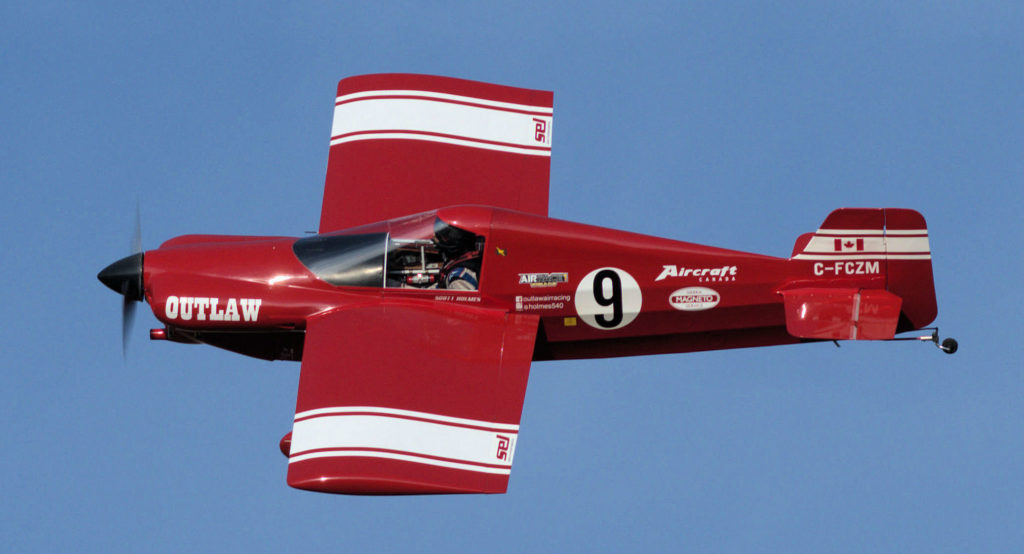Estimated reading time 5 minutes, seconds.
Canada’s Scott Holmes is aiming to be the young upstart when he goes wingtip-to-wingtip with the best air racing pilots in the world next week–in the fastest motor sport on the planet.
Holmes, born and bred in Edmonton, Alta., will be competing at the Air Race 1 World Cup presented by Chang at Thailand’s U-Tapao Naval Airbase from Nov. 17 to 19.

The 27-year-old, an engineer at a chemical plant in his home city, will be the youngest pilot in the cockpit when he lines up against 16 other highly-skilled race pilots at the world’s premier airborne series, known as the formula one of air racing.
Hosted by the Sports Authority of Thailand, part of the Ministry of Tourism and Sport, the world’s purest air race challenges pilots in a demanding test of skill. Each race sees up to eight pilots go head-to-head on a tight oval circuit at speeds of over 400 kilometres per hour just metres above the ground.
Holmes will be racing for the Outlaw team in a Cassutt racer aircraft, and he is aiming to do his country proud.
“I can’t wait to get over to Thailand, get my plane out of the container and get airborne,” said the University of Alberta graduate.
“It’s an amazing event to be part of, and I’ll be giving it my best shot. I’ll be the only Canadian racing, and having the chance to represent my country is a huge honour.”
Holmes has been flying for a decade, after earning his pilot’s licence at the tender age of 17.
His aerobatics expertise will come in handy as aircraft can, without warning, be rolled upside down during races by wake turbulence.
Holmes, who lives in the Windermere neighbourhood of Edmonton, admits he is way behind most of his rivals in terms of flight experience, with this also being only his third formula one air racing event.
However, he is still confident he can rattle some cages.
“I wanted to be a fighter pilot when I was 10 and came up through the Canadian air cadet program, earning a scholarship to do my pilot licence at 16,” recalled Holmes.
“I quickly discovered other types of flying I found more exciting than flying fighters, and [I] bought my first race plane in 2014. I was then invited to compete in Air Race 1 after doing well at the National Formula One Air Racing Championships in Reno, [Nev.].
“In Thailand, I think I’ll be the only competitor who doesn’t work in aviation in a professional capacity. I only have 300 hours [of] flight experience, while most of the other guys will have over 1,000.
“That does make me a little nervous, but I try to make up for my lack of experience by flying my race plane as much as I can.
“I can’t wait to go up against the more experienced guys. As in all sports, anything can happen on the day,” Holmes added.
Despite covering so much ground in his plane, Holmes admits he isn’t exactly well travelled.
“It will be nice to fly in a warm country, not having to wear a coat and rely on the plane’s cabin heat to warm me up,” quipped Holmes.
“I’ve never been to Asia. In fact, I’ve only been off the continent once, to visit Europe when I was 14. I don’t even think I’ve seen the ocean from my cockpit before.
“Thankfully, I’ve got an amazing crew behind me, as well as some amazing sponsors like Aircraft Canada and Sierra Magneto Service. Without them, I’d be nowhere. I’ve got a lot to thank them for.”
To ensure a fair competition between pilots, each plane must be built to a specific formula that covers most aspects of the race plane’s characteristics, including wing area, weight and engine size.
The class of airplanes incorporate the most modern materials and cutting-edge technology for those all-important marginal gains.
As in all motor sport, an element of success is down to the designers, engineering teams and ground crew support in the pits. Many of the pilots and teams design and build their own race plane to capitalize on unique innovations.